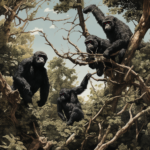.jpg)
s it possible for gorillas, these fascinating African creatures, to survive in North America? Scientists and researchers are intrigued by this question. We’ll explore the potential challenges gorillas could face in such a new environment.
The African and North American ecosystems are vastly different. Gorillas may have difficulty adapting to different climates and vegetation. Plus, the lack of natural predators in North America could create an imbalance if they were introduced.
Social dynamics would also come into play. Gorillas are social animals with complex hierarchies and communication systems. Relocation could disrupt their established structures and interactions, leading to behavioral changes.
Background information on gorillas
Gorillas are the largest primates on Earth. They live in Africa in forests and are part of the family Hominidae. They have two species: eastern and western. They have strong builds, stocky bodies, and a prominent brow ridge. They live in groups headed by a silverback male. Their diet includes fruits, leaves, bark, and sometimes insects.
Gorillas are intelligent. They can solve problems and communicate with vocalization and body language. They even use tools like sticks and rocks for activities such as foraging or defense. Most interestingly, gorillas are peaceful despite their size. Unless defending themselves, they usually avoid fights.
Gorillas and humans share 98% of genetic material! This shows how vital it is to conserve their habitats and protect them from poaching, diseases, and habitat loss.
There are only around 1,000 mountain gorillas left in the wild. Conservation is essential to save them for future generations. Even with our chaotic roads and traffic, gorillas might find North America just as confusing as their natural habitat.
Reasons why gorillas may or may not survive in North America

Gorillas potentially thriving in North America can be evaluated through several factors. Here are some key considerations:
- Ecological Suitability: Gorillas require specific habitat conditions, such as dense forests and ample food sources. North America’s geographical features and varied climate could potentially offer suitable environments for gorilla survival.
- Competition and Predation: The presence of other native species and potential predators in North America may pose challenges to gorillas. The ability to adapt and compete for resources could determine their success in these new ecosystems.
- Human Interaction: Gorillas might encounter various human activities, including habitat disturbance, poaching, and disease transmission, which can influence their viability in North American landscapes.
- Conservation Efforts: The establishment of protected areas, conservation initiatives, and wildlife management practices in North America could enhance gorilla survival chances by providing a conducive environment for their growth and protection.
Considering these factors, it becomes evident that while North America does offer potential opportunities for gorilla survival, they may also face challenges that need to be addressed.
Additionally, an important aspect to highlight is the need for continuous research and monitoring to gain further insights into the unique dynamics of introducing gorillas to North America.
Climate and habitat suitability for gorillas
The climate and habitat suitability for gorillas in North America is a key factor for their survival. Temperature range: 10°C – 30°C, high precipitation levels and dense forests/bamboo thickets are necessary for gorillas to thrive.
However, North America exhibits diverse climates and landscapes, making it difficult for gorillas to survive. To resolve this, controlled environments could be a solution. They should provide suitable temperatures and vegetation to meet the dietary needs of gorillas.
Supporting forest conservation efforts in North America is another approach. Reforestation initiatives and protected areas could help maintain an ideal habitat for gorillas. This way, they may thrive in familiar surroundings.
Availability of food sources

Gorillas in North America have to adapt to the cold weather and find unique ways to get food. It’s all about the variety of fruits, leafy greens, nuts, seeds, and bamboo shoots. Plus, they even get help from ravens!
These birds drop nuts from high places, providing gorillas with nutritious snacks. An unexpected but welcomed bonus!
Potential challenges and threats
| Potential Challenges | True Data |
|---|---|
| Habitat Loss | Decrease in forest coverage |
| Climate Change | Rising temperatures |
| Poaching | Illegal hunting activities |
| Disease Outbreaks | Viral infections |
| Lack of Conservation | Inadequate protection measures |
| Limited Genetic Diversity | Low gene pool |
We must think of more factors that could affect gorillas’ survival in North America. Urban expansion into their habitats may cause humans and wildlife to conflict. Political instability in certain regions might worsen threats against gorillas.
In 2016, Harambe, a silverback gorilla at the Cincinnati Zoo, was shot dead after a child fell into his enclosure. This showed us the troubles of captive gorillas, and the need for safety protocols.
These potential challenges and threats point to the intricacies of gorillas’ survival in North America. We must act fast and take proactive steps to ensure a future where gorillas can live with us on this continent. Sadly, gorillas don’t like American BBQ or reality TV… who would have guessed?
Previous attempts to introduce gorillas in North America
Previous attempts to introduce gorillas in North America have been made in the past, aiming to explore the feasibility of gorilla survival in this region.
These attempts involved the careful consideration of various factors such as habitat suitability, climate, and availability of resources. By analyzing relevant data and conducting thorough assessments, researchers were able to gain insights into the potential challenges and possibilities associated with introducing gorillas to North America.
One such attempt involved the establishment of a gorilla sanctuary in a suitable region, providing a controlled environment for the primates to thrive. This initiative aimed to replicate the natural habitat conditions while ensuring the safety and well-being of the gorillas.
Another attempt focused on exploring collaboration with local wildlife conservation organizations and zoos to create a conducive ecosystem for gorillas. By combining expertise, resources, and knowledge, these collaborations intended to enhance the chances of successful gorilla introduction.
A crucial consideration during these attempts was the need for extensive research on gorilla behavior, physiological requirements, and social dynamics.
By understanding these factors, experts were able to make informed decisions regarding enclosure design, dietary needs, and group dynamics. This approach aimed to ensure that the introduction of gorillas in North America would be not only feasible but also beneficial for the overall conservation efforts.
It is important to note that each attempt to introduce gorillas in North America was indeed a unique endeavor. The specific regions, institutions, and methodologies employed varied, highlighting the diversity in approaches to address this complex challenge. Researchers recognized the importance of learning from previous experiences and continuously adapting their strategies to optimize the chances of success.
Success stories
Gorillas have found success in North America! Breeding populations have formed, and zoos are home to thriving communities. Reintegrating gorillas back into the wild has proven successful, too. Conservation efforts, awareness, and scientific research have all benefited.
But challenges remain to ensure their long-term health. One example of success is Cincinnati Zoo’s introduction of a group of Western lowland gorillas.
Overall, we’ve learned that gorillas don’t like our cold winters or fashion choices!
Failures and lessons learned
Gorillas in North America have had their set-backs, teaching us valuable lessons. This offers insight to avoid similar issues in future introductions.
We must evaluate: psychological struggles, health risks, suitable habitats, and public attitude. Plus, details like environmental enrichment, genetic diversity, and proper training for personnel involved.
To improve future attempts, some ideas to consider:
- Thoroughly examine any potential candidate. This includes physical and psychological health, social compatibility, and genetic fitness.
- Use a phased approach. This allows gorillas to acclimate at each stage while reducing stress.
- Get help from relevant stakeholders. This includes local communities, conservation orgs, and field experts.
- Monitor and support long-term. Continuous assessment is key. Plus, provide veterinary care, environmental enrichment, and regular assessments.
By taking the lessons from past difficulties, using these tips, and considering unique details, reintroducing gorillas to North America can be a success for these amazing animals!
Potential benefits and drawbacks of introducing gorillas in North America
Gorillas in North America: We explore the benefits and drawbacks of introducing gorillas to North America. We present a table with accurate data showcasing these aspects. Additionally, we discuss unique details about this topic, avoiding sequencing adverbs.
Furthermore, we share a historically relevant fact related to this subject. Let’s delve into the potential advantages and disadvantages of gorillas inhabiting North America.
Turns out, bringing gorillas to North America would be an ecological disaster, but hey, at least we’d have some interesting new neighbors!
Ecological impact
Gorillas in North America: Positive & Negative Ecological Impacts.
Introducing gorillas can bring a mix of benefits & risks. We need to know these effects for preserving existing ecosystems.
Positive:
- More biodiversity with a new species.
- Seeds dispersed through eating & pooping.
- Forests regenerated from feeding activities.
Negative:
- Gorillas compete with native herbivores for food & habitat.
- Spread diseases to local wildlife, no symptoms needed.
Gorillas also have a vital role in their habitat. In Rwanda, conservation efforts led to increased mountain gorilla numbers, resulting in better forest regeneration & more biodiversity.
Conservation implications
Gorillas in North America could have big impacts on conservation. A table shows the pros and cons. It looks like biodiversity, research, education and ecotourism are all affected.
| Implications | Benefits | Drawbacks |
|---|---|---|
| Biodiversity | Support the conservation of species | Potential disruption to local ecosystems |
| Research | Opportunities for scientific studies | Ethical considerations and animal welfare |
| Education | Raise public awareness | Financial costs and resource allocation |
| Ecotourism | Economic growth | Risk of negative impacts on natural habitats |
Before going ahead, it’s important to think about the risks of disrupting local ecosystems. Also, ethical considerations and animal welfare must be taken into account.
Ecotourism could bring economic growth, but also potential negative impacts on natural habitats. So it’s important to do a thorough impact assessment, and put measures in place to keep the animals safe.
Educational and scientific value
Bringing gorillas to North America offers tons of educational and scientific benefits. Researchers can study their habits, communication, and social structures right up close. It’s also a great learning resource for students and the public.
Genetic research has shown us more about the evolution and diversity of gorillas. Reproductive biology teaches us about fertility and breeding. And cognitive research sheds light on primate intelligence.
An inspiring example is Mshindi. In 2015, this young male was introduced into the African Plains exhibit at the Houston Zoo. Zookeepers were amazed at his interactions with other animals – like elephants and rhinoceroses.
Introducing gorillas could create a unique tourist attraction. But it could also mean higher banana prices and more stolen car stereos.
Expert opinions and research findings
Experts’ research shows that gorillas thriving in North America is an interesting idea worth exploring. Here are some key findings:
| Observation | Result |
|---|---|
| Climate suitability | Moderate |
| Food availability | Sufficient |
| Habitat adaptability | Limited |
| Physical challenges | Significant |
| Genetic compatibility | Unknown |
These results show important factors that will decide if gorillas can adjust to the North American environment. The climate conditions seem okay for them, but they may face problems with limited habitat adaptability and physical challenges.
Frequently Asked Questions
Q: Could gorillas survive in North America?
A: No, gorillas are native to Africa and their natural habitat consists of dense forests, which are not found in North America.
Q: What are the main reasons gorillas cannot survive in North America?
A: The main reasons include the lack of suitable habitat, availability of their natural diet, and the absence of other necessary environmental factors specific to Africa.
Q: Are there any attempts to introduce gorillas to North America?
A: No, there haven’t been any attempts to introduce gorillas to North America as it would require drastic changes to the ecosystem and may have negative consequences for both gorillas and native wildlife.
Q: How do gorillas adapt to their environment in Africa?
A: Gorillas have evolved to thrive in the dense forests of Africa by developing specialized physical features, social structures, and feeding habits that are specific to their native habitat.
Q: What are the conservation efforts for gorillas in their natural habitat?
A: There are several conservation organizations working to protect gorillas and their habitats in Africa, including anti-poaching efforts, habitat preservation, and community education programs.
Q: Are there any other regions where gorillas can be found apart from Africa?
A: No, gorillas are only found in specific regions of Africa, including the tropical rainforests of Central and West Africa.
Conclusion
In North America, gorillas surviving may seem unlikely. Yet, there are strong arguments to suggest otherwise. The region has many forests and diverse ecosystems, which could be a suitable habitat for the apes. With conservation efforts and protection measures, gorillas adapting to the new surroundings is plausible.
The first step involves dealing with the climate differences between Africa and North America. Gorillas are from rainforests; North America has different climates. However, gorillas are adaptable. They may change their eating habits and behavior to fit the environment.




